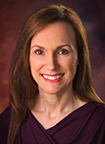 LeAnna Stork is the team lead for the Regulatory Statistics Technology Center at Monsanto Co. Stork earned her bachelor’s in statistics from the University of Nebraska at Kearney, master’s in biometry from the University of Nebraska-Lincoln, and PhD in biostatistics from Virginia Commonwealth University.
LeAnna Stork is the team lead for the Regulatory Statistics Technology Center at Monsanto Co. Stork earned her bachelor’s in statistics from the University of Nebraska at Kearney, master’s in biometry from the University of Nebraska-Lincoln, and PhD in biostatistics from Virginia Commonwealth University.
My career as an applied statistician at Monsanto began nearly 10 years ago, after completing my graduate degrees. I currently lead a team of statisticians working in an interdisciplinary environment. The pace of my work week is rapid, but I learn something new every day. I knew from Day 1 that I wanted to use my statistical knowledge and develop leadership skills to help solve real-world challenges in an attempt to improve agricultural productivity as a means to feed an ever-growing population. For me, this career goal meant not being simply a number cruncher, but also a collaborator and leader.
When I started my job, I immediately began working in an interdisciplinary environment with many talented scientists in a variety of domains, including agronomy and biology. I soon realized that to be the best statistician and collaborator I could be, I would need to think in ways similar to them and learn as much about the subject matter as I could.
To do this, I began meeting with the scientists, asking them questions about their research and experiments, and visiting the labs and fields where the studies were being conducted. This was vital to helping me better understand the real-world conditions and challenges they faced in conducting agricultural research, as well as the sources of variability that would be important in the statistical models.
The first couple of years in my role, I took on as many different projects as possible and gained a better understanding of how to use the tools in my statistical toolbox to help ask and answer important questions. As tempting as it was to email colleagues with questions about their data, or for help with an analysis, I found it was ultimately most beneficial to walk down the hall or pick up the phone and have a conversation. This provided a collaborative environment for discussion, knowledge exchange, and mutual understanding of the question, challenges, and solutions. It also helped me build professional relationships and expand my network in a meaningful way. These collaborations have led to recognition, several publications, and new and exciting opportunities.
Collaborating in an interdisciplinary environment has been exciting, but not without challenges. Excellent communication skills are essential for any successful collaboration. As a consulting statistician, I need to listen to my customers, understand their goals, and appreciate their challenges. Being flexible is another important skill I often use to help find the balance between statistical theory and real-world application.
During my career, I have not been afraid to work on projects or in teams that require little or no statistical work. In fact, I have taken advantage of as many leadership and professional development opportunities, both internally and externally, as I can.
Examples include participating in mentoring programs as both a mentee and mentor, co-chairing a steering team that developed a two-week scientific strategy training, participating in a three-month business strategy program, serving on a Women in Science leadership team, and serving as the chair of the ASA’s Conference on Statistical Practice Steering Committee.
These opportunities have had a positive effect on my career development because they have encouraged me to expand my networks, broaden my knowledge of the business and industry, increase my visibility, and use my skills and strengths in new ways.
It is important for statisticians to develop skills to clearly and concisely present their proposals, methods, results, and recommendations to their stakeholders and leadership for mutual understanding and approval.
Giving presentations to large groups does not come naturally for me. To help overcome this challenge, I find as many opportunities as possible to give presentations to large groups. The topic of the presentation does not always need to be technical. In fact, I recently gave a safety presentation to a group of more than 100 people on distracted driving. Participating in these types of speaking opportunities has helped enhance my public-speaking skills and confidence. I also recently joined Toastmasters International, which empowers members to develop communication and leadership skills.
Identifying coaches and mentors has been, and continues to be, a critical component in my career development. Technical coaches have helped me think about scientific problems and solutions in ways I may not have considered otherwise. They also have helped me expand my knowledge of subject matter in other scientific disciplines. In addition, I have had numerous mentors who have helped me broaden my understanding of the business, shown me how to work through challenging situations, and helped me refine my career development goals.
My career development journey has been exciting and rewarding. As a statistician team lead, I have the opportunity to use my statistical tools and leadership skills. I have done this while working in an interdisciplinary environment to help solve the real-world challenges presented by an ever-growing world population. Career development is a continuous and evolving process that I will continue to make a priority, and I would challenge any statistician to do the same.




Leave a Reply